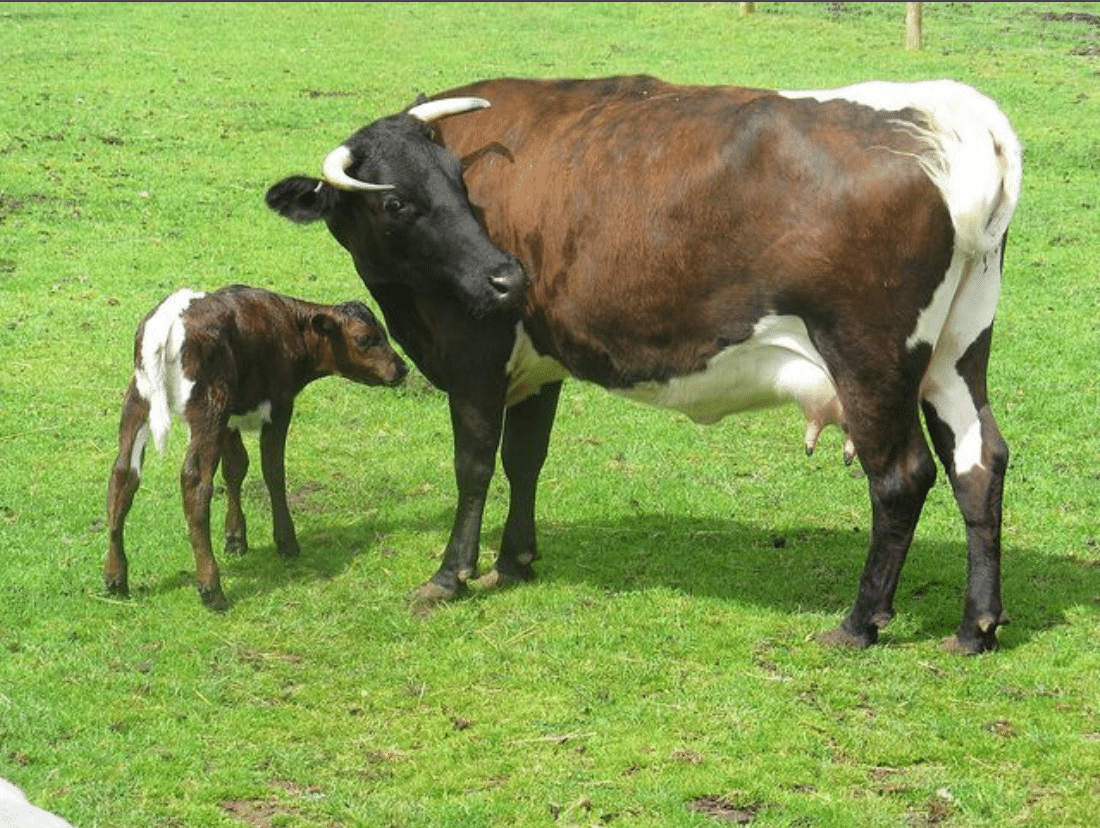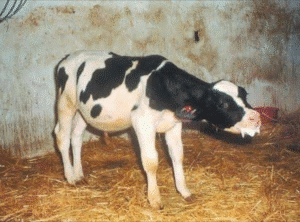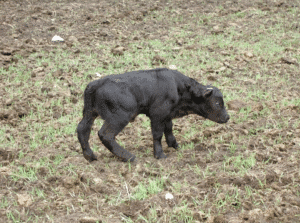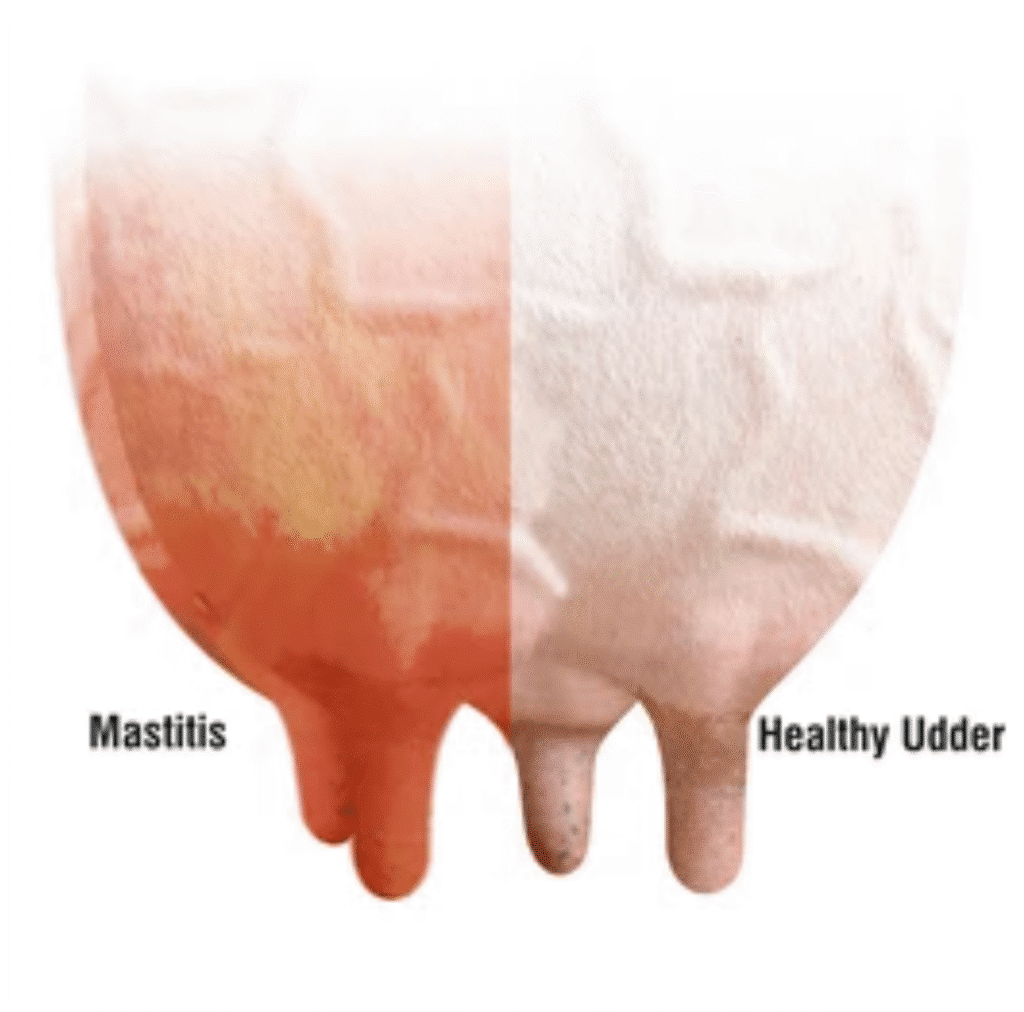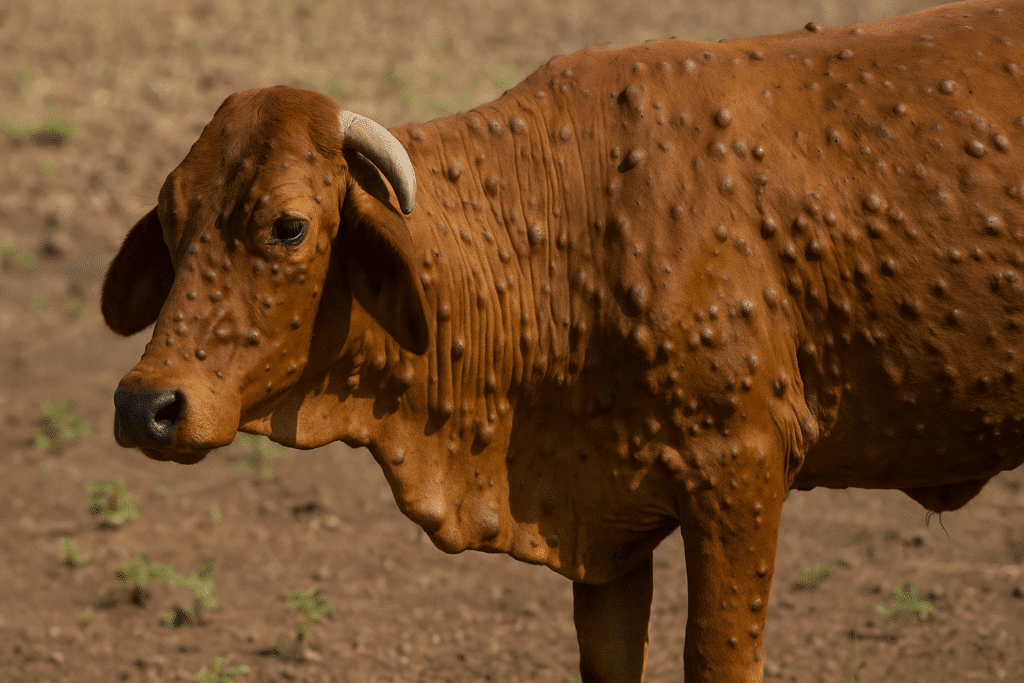Bovine Viral Diarrhea (BVD) is a widespread, highly contagious cattle disease that affects cattle of all ages, with the greatest impact in calves aged 6 to 24 months. Bovine Viral Diarrhea, sometimes called BVD-MD (Bovine Viral Diarrhea–Mucosal Disease), mainly affects a cow’s immune system, digestive tract, and reproductive organs. Infected herds often experience reduced milk yields, slower growth, fertility issues, and higher mortality rates, resulting in significant economic losses for farmers.
Bovine Viral Diarrhea disease is caused by the infectious virus called Bovine Viral Diarrhea Virus (BVDV), a member of the Pestivirus genus in the Flaviviridae family. Once the virus enters the animal’s body, it spreads rapidly, and signs of illness typically appear within 5 to 7 days. Bovine viral diarrhea also causes strong immune suppression in infected cattle.
Infected cattle often develop high fever (105–107 °F), bloody diarrhea in calves, loss of appetite, mouth ulcers, nasal discharge, and breathing difficulty. In severe cases, diarrhea in cattle may become persistent and lead to dehydration and death.
Pregnant cows are especially at risk, as infection frequently results in abortion, stillbirth, or the birth of weak or deformed calves. When infection occurs during early pregnancy, the developing fetus may survive but become persistently infected (PI), shedding the virus throughout life and spreading it to healthy animals.
There is no specific cure, but supportive care and proper management can reduce losses and help affected animals recover.
Clinical Signs and Symptoms of Bovine Viral Diarrhea
The common symptoms of bovine viral diarrhea include a mild fever, reduced appetite, dullness, and a sudden drop in milk yield. As the condition progresses, the digestive system is usually the first to show clear trouble. Many animals develop watery or sometimes bloody diarrhea, and it’s not unusual for a farmer to spot a cow with diarrhea and weight loss. Painful mouth ulcers, drooling, and reluctance to eat are also common bovine viral diarrhea symptoms, especially in stressed or young animals.
Because BVD weakens the immune system, affected cattle often develop respiratory infections. Coughing, nasal discharge, watery eyes, or general breathing difficulty are typical pneumonia symptoms in cows. They usually appear a few days after digestive issues.
Reproductive problems are another strong indicator of BVD symptoms in cattle, particularly in herds where cows are experiencing repeat breeding, early embryo loss, or unexplained abortions. In newborn calves, BVD can lead to thrombocytopenia in neonates, causing unusual bleeding or weakness.
Persistently infected (PI) calves are often the silent source of BVD in cattle throughout a herd. These calves tend to have chronic diarrhea, a rough hair coat, slow growth, and recurrent respiratory disease. Their symptoms can easily be mistaken for other sicknesses in cattle, including infections like bovine rotavirus or BRD(Bovine Respiratory Disease), but the long-term pattern points back to BVD. In some cases, bulls or young males may also show diarrhea and sore testicles, adding another sign that the infection is circulating. When digestive problems, breathing issues, reproductive losses, and weak calves appear together, it strongly suggests active BVD in the herd.
Causes of Bovine Viral Diarrhea in Cattle
Bovine Viral Diarrhea in cattle is caused by the Bovine Viral Diarrhea Virus (BVDV). BVDV belongs to the Flaviviridae family and the Pestivirus genus, which are known for viruses that can suppress the immune system. There are two main types of BVDV responsible for BVD in cattle:
- Type 1 – Usually causes milder illness.
- Type 2 – Less common but often more severe, sometimes leading to sudden outbreaks and higher death rates.
These two types are the main reasons BVD spreads in herds and causes health problems in cattle. Beyond these two main types, BVDV has several variants and subtypes. Some of these variants cause mild, long-lasting infections, while others can trigger severe disease.
These differences in the virus allow it to stay in herds for years, quietly spreading even when cows seem healthy. This is why controlling BVD in cattle can be so difficult.
Pathogenesis
After infecting a cow, BVDV attacks immune cells, which weakens the animal’s ability to fight off other infections. This immune suppression is a key reason infected cattle often develop multiple diseases. The virus also affects the digestive system, causing diarrhea, poor weight gain, and loss of condition.
If a cow becomes infected during early pregnancy, BVDV can harm the developing calf, creating Persistently Infected (PI) calves. These PI calves carry the virus their entire lives and constantly spread BVDV to other animals. Because of them, the disease can stay in a herd even when all other cattle appear healthy.
Diagnosis of Bovine Viral Diarrhea (BVD) in Cattle
Accurately diagnosing Bovine Viral Diarrhea (BVD) begins with careful observation of the herd. Early warning signs such as watery diarrhea, fever, mouth ulcers, sudden weakness, or calves born weak or deformed can all point toward BVD. Because these symptoms can resemble other cattle diseases, proper testing is essential to confirm whether BVD is present.
Once BVD is suspected, veterinarians use a variety of testing methods to determine whether the infection is new, ongoing, or caused by a persistently infected (PI) animal. Conducting multiple forms of testing helps ensure that no infected animal—especially silent PI carriers goes undetected.
Common Tests Used for Bovine Viral Diarrhea Diagnosis
Here are the most reliable testing methods for identifying BVD in cattle:
- Serology (Antibody Testing): Detects whether an animal has been exposed to the BVD virus in the past.
- PCR Testing: A highly accurate method that identifies viral RNA in blood, tissue, nasal swabs, or ear notch samples. This is one of the most reliable methods for testing for bovine viral diarrhea.
- Antigen-Capture ELISA: Quickly detects viral antigens and is widely used in BVD PI testing to identify persistently infected animals.
- Ear Notch / Tissue Testing: A standard tool for screening newborn calves, newly purchased animals, or entire herds for PI carriers.
- Bulk Tank Milk Testing: A practical option for dairy herds, allowing detection of recent BVD activity without sampling cows individually.
Using these testing methods gives farmers and veterinarians a clear understanding of the herd’s health status. Early detection through effective BVD testing makes controlling the disease easier, helps reduce its spread, and protects both adult cattle and young calves from long-term losses.
Bovine Viral Diarrhea Treatment
Bovine viral diarrhea doesn’t have a specific cure. Treatment usually focuses on supportive care—making sure the animals stay hydrated, get proper nutrition, and are protected from any additional health problems. The goal of BVD treatment in cattle is to help the animal stay strong while its immune system fights off the infection.
To manage fever and general discomfort, vets usually reach for anti-inflammatory medications such as flunixin meglumine (Banamine®) or meloxicam. These help bring the fever down, ease gut irritation, and reduce the pain from mouth sores so the animal can eat and heal better.
If there’s a risk of secondary infections, especially pneumonia, your veterinarian may also recommend bovine antibiotics such as oxytetracycline, florfenicol, or tulathromycin. These help protect the cattle from bacteria that can take advantage of their weakened immune system during BVD.
Always consult a veterinarian to confirm a diagnosis of Bovine Viral Diarrhea. The veterinarian will confirm the diagnosis and prescribe treatment according to your animal’s needs. Also, be careful when using supplements. Changes in location, weather, or the animal’s history may require adjustments to the prescription.
Here are some key points to keep in mind when your cattle have bovine viral diarrhea.
Supplements to Help Cattle Recover from BVD
When cattle contract Bovine Viral Diarrhea (BVD), they often develop diarrhea, dehydration, weakness, and loss of appetite. Along with proper veterinary care and treatment, giving the right supplements can make a big difference in how quickly they recover. Here’s a practical guide to the most important supplements for BVD recovery:
- Electrolytes for Hydration: Diarrhea from BVD can quickly dehydrate cattle, so keeping them hydrated is critical. Oral electrolytes like Resorb®, Bounce Back® (Manna Pro), or Vytrate® Oral Rehydration Solution restore essential salts, glucose, and energy. For severely dehydrated or very weak animals, a veterinarian may give IV fluids such as Ringer’s Lactate or Normal Saline.
- Vitamin B-Complex for Energy and Appetite: Weak cattle often struggle to eat due to fever or mouth ulcers. Vitamin B-Complex injections, including brands like Bovikalc® B-Complex, can boost metabolism, stimulate appetite, and help them regain strength faster.
- Vitamin C for Immunity: BVD and the stress of illness can weaken the immune system. BVD often weakens a cow’s immune system, especially when the animal is already stressed. Giving vitamin C, such as Ascorbic Acid injections or Vita-C®, can help boost immunity and support the animal as it fights the infection.
- Energy Boosters: Quick energy sources are important for weak animals, especially calves. Propylene Glycol, Dextrose powders, or Molasses mixes provide fast energy to keep cattle active, encourage feeding, and support recovery from diarrhea.
- Probiotics for Gut Health: Diarrhea can upset the gut and destroy beneficial bacteria. Probiotics like Protexin® Ruminant, Calf-Guard®, or Probios® Bovines Oral Gel help restore healthy gut flora, improve digestion, and speed up recovery.
Prevention of BVD in Cattle
Prevention of BVD starts with vaccination. Giving your cattle a reliable bovine viral diarrhea vaccine keeps them healthy and stops the virus from spreading. Along with vaccination, good biosecurity is essential—limit contact with new or unknown animals, disinfect equipment regularly, and control movement on your farm to reduce the risk of infection.
Proper herd management also plays a key role. Keep watching your animals regularly and separate any that don’t seem right. Calves need special attention. When the cows have good feed, clean water, and a calm environment, their immune system stays strong, and BVD is less likely to hit. It’s always better—and cheaper—to prevent it than to deal with it later.
Herd Health Management and Biosecurity
Good management practices form the backbone of BVD prevention. A few simple steps can dramatically reduce the risk of bringing the virus into your herd:
- Keep new or returning animals separate from the main herd until you’re confident they’re healthy.
- Any cow showing signs of illness should be isolated immediately to stop the virus from spreading.
- Pay extra attention to calves—if you notice diarrhea, fever, or weakness, monitor them closely.
- Clean and disinfect waterers, feeders, and equipment regularly.
These basic actions not only help with BVD but also reduce the risk of viral diarrhea in calves, which often occurs when the virus is active in the herd.
Nutritional Support for Prevention
Healthy cattle fight off infections more effectively, and nutrition plays a huge role in that:
- Provide a balanced feed with the appropriate levels of protein, vitamins, and minerals.
- Consider supplements like Vitamin B-Complex, Vitamin C, and essential trace minerals such as Copper, Zinc, and Selenium to strengthen immunity.
- Always ensure animals have clean, fresh water and enough space to eat to avoid stress.
When cattle eat well after getting their BVD shot, their immune system works more effectively and builds stronger immunity.
Routine Monitoring and Farm Hygiene
Even when your herd is vaccinated, regular monitoring is still important:
- Watch for early signs like diarrhea, fever, or poor growth.
- Keep bedding dry and clean to reduce contamination.
- Handle and transport cattle gently—stress can make them more vulnerable to disease.
Vaccination for Bovine Viral Disease
Vaccination remains the most reliable and long-term method of preventing BVD. Using a reliable BVD vaccine for cattle and administering it at the correct age and interval creates a strong shield for the herd. Calves, heifers, and pregnant cows especially benefit from timely immunization.
Recommended BVD Vaccines
Below are commonly used and trusted vaccines that farmers rely on:
- Bovi-Shield Gold® 5 – a well-known BVD vaccine that protects against BVD along with other respiratory diseases. Young calves usually receive two doses, but follow your vet’s exact recommendation.
- Pestigard® BVD Vaccine – protects against several strains of BVD. It is generally given under the skin, with boosters as advised by your vet.
- Cattle Master® Gold FP5 – protects against BVD, IBR, and more. Suitable for calves older than 2 months.
- Vista® Once SQ – a single-dose option often called a BVD one-shot vaccine. Many farmers prefer it for adult cows and replacement heifers because it’s convenient and effective.
Vaccination Tips for Farmers
- Stick to the schedule your veterinarian recommends.
- Keep a proper record of every vaccinated animal.
- Vaccination works best when combined with good biosecurity and clean management practices.
- Only use pregnancy-safe vaccines for pregnant cows to avoid complications.
Consistent BVD cattle vaccination greatly reduces the risk of silent infections and keeps your herd safer in the long run.
Conclusion
Bovine Viral Diarrhea (BVD) is a highly contagious and economically significant disease affecting cattle of all ages, with calves being most vulnerable. Bovine diarrhea is caused by Bovine viral diarrhea virus (BVDV). The virus targets the immune, digestive, and reproductive systems, leading to diarrhea, fever, poor growth, reproductive failures, and even death. Persistently infected (PI) animals act as silent carriers, perpetuating virus spread within herds.
Since BVD can’t be cured, the key is to catch it early and handle sick animals properly to avoid larger losses. Paying attention to symptoms, keeping a close eye on the herd, and running tests such as PCR, serology, or ear-notch checks help you identify which animals are infected. Treatment focuses on hydration, nutrition, and prevention of secondary infections, often supplemented by vitamins, electrolytes, probiotics, and energy boosters.
The most reliable way to control BVD is to prevent it. That means proper vaccination, tight biosecurity, regular herd checks, and keeping the animals well-fed and managed. When these steps are followed together—vaccinating on time and keeping the farm secure—it really helps protect the herd and limits how far the virus can spread.
FAQs: Bovine Viral Diarrhea in Cattle and Calves
What is bovine viral diarrhea?
Bovine Viral Diarrhea (BVD) is a contagious cattle disease caused by the BVD virus. It mainly affects a cow’s immune system and digestive tract, leading to conditions such as fever, diarrhea, poor growth, and reproductive losses. The virus spreads easily through direct contact, contaminated equipment, or infected calves—especially persistently infected (PI) animals that shed the virus for life.
What does BVD stand for?
BVD stands for Bovine Viral Diarrhea, a contagious viral disease in cattle that affects the digestive system, immunity, and reproductive health. It can cause diarrhea, fever, reduced performance, and serious issues like miscarriages or weak newborn calves.
Which of the following causes bovine viral diarrhea?
Bovine Viral Diarrhea (BVD) is caused by the Bovine Viral Diarrhea Virus (BVDV), which belongs to the Pestivirus genus in the Flaviviridae family. This virus infects cattle, weakens their immune system, and spreads easily through direct contact with infected animals, contaminated equipment, or persistently infected (PI) calves.
What is BVD in medical terms?
BVD (Bovine Viral Diarrhea) medically is a viral infection in cattle that affects the immune system, digestion, and reproduction. It causes diarrhea, fever, poor growth, and reproductive problems, and is managed through diagnosis, supportive care, and vaccination, since there is no specific cure.
How to treat diarrhea in calves?
Treating diarrhea in calves mainly involves keeping them hydrated with oral electrolytes or IV fluids if they’re very weak. They should still get small, regular feedings of milk or milk replacer, and probiotics can help settle the gut. A clean pen reduces the risk of new infections, and a vet should guide any medicines or follow-up care.
What does BVD look like?
BVD causes diarrhea, fever, mouth ulcers, nasal discharge, breathing difficulty, poor growth, and weak or deformed calves. Persistently infected calves may appear small, weak, and sickly, often spreading the virus without obvious signs.

